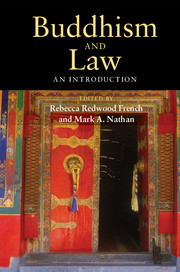Book contents
- Frontmatter
- Dedication
- Contents
- Maps and Illustrations
- Contributors
- Preface
- Abbreviations
- Introducing Buddhism and Law
- Part I The Roots of Buddhism and Law in India
- Part II Buddhism and Law in South and Southeast Asia
- Part III Buddhism and Law in East Asia
- 11 Buddhism and Law in China
- 12 The Ownership and Theft of Monastic Land in Ming China
- 13 Buddhism and Law in China
- 14 Buddhism and Law in Korean History
- 15 Buddhism and Law in Japan
- 16 Relic Theft in Medieval Japan
- Part IV Buddhism and Law in North Asia and the Himalayan Region
- A Selection of Readings
- Index
- References
12 - The Ownership and Theft of Monastic Land in Ming China
Published online by Cambridge University Press: 05 August 2014
- Frontmatter
- Dedication
- Contents
- Maps and Illustrations
- Contributors
- Preface
- Abbreviations
- Introducing Buddhism and Law
- Part I The Roots of Buddhism and Law in India
- Part II Buddhism and Law in South and Southeast Asia
- Part III Buddhism and Law in East Asia
- 11 Buddhism and Law in China
- 12 The Ownership and Theft of Monastic Land in Ming China
- 13 Buddhism and Law in China
- 14 Buddhism and Law in Korean History
- 15 Buddhism and Law in Japan
- 16 Relic Theft in Medieval Japan
- Part IV Buddhism and Law in North Asia and the Himalayan Region
- A Selection of Readings
- Index
- References
Summary
Landowning was a universal condition of monastic survival in late-imperial China. Some Buddhists might like to invoke the ancient ideal of begging, but when it came to running a monastery, itinerant almsgiving was inadequate. “When the eating fingers become daily more numerous, begging for food does not meet the need, so the monastery has to have property in land,” as a patron put it. Or as an abbot phrased it, “How can a monastery remain secure in the long term with only a little permanent property?” Master Hanshan Deqing (1546–1623) was blunter, declaring that “land is the foundation of a Buddhist abbey.”
While the law of monastic property was almost entirely the law of the state in Imperial China, the law of the Buddha had some influence as well. Few contemporaries wrote on ownership of Buddhist property as a general topic, but many were inspired to write about theft, which is why theft will serve as my approach to the legal status of Buddhist property in the Ming Dynasty (1368–1644). Theft looms as a constant threat in the principal sources for this essay, the gazetteers compiled by monasteries to record their history and protect their assets. The monastery that did not lose a significant piece of property was as rare as the monastery that owned none at all. With property the norm and theft the fate, attachment to property was the condition.
- Type
- Chapter
- Information
- Buddhism and LawAn Introduction, pp. 217 - 233Publisher: Cambridge University PressPrint publication year: 2014



